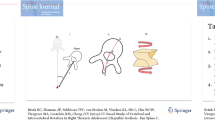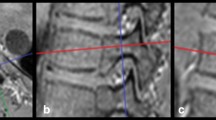Abstract
Purpose
Cadaveric studies have previously documented a typical pattern of venous drainage within vertebral bodies (VBs), comprised primarily of the basivertebral vein. These studies, however, are limited by the number of samples available. MRI is able to provide 3D images of soft tissue structures in the spine, including the basivertebral vein without the use of contrast in both healthy controls and subjects with abnormal anatomy such as adolescent idiopathic scoliosis (AIS). This study aimed to quantify the venous networks within VBs of 15 healthy adolescent controls and 15 AIS patients.
Methods
Five transverse slices through the VBs were examined simultaneously and the observable vascular network traced. The length of the network on the left and right sides of the VB was calculated, and the spatial patterning assessed level-by-level within each subject.
Results
Significant differences were seen in the left/right distribution of vessels in both the control and AIS subjects, with both groups having greater length on the right side of all of their VBs. No difference was seen between AIS and control subjects in any region. Large individual variations in patterns were seen in both groups; however, the control group showed more consistent spatial patterning of the vascular networks across levels in comparison to the AIS group.
Conclusion
The length of the basivertebral vein was seen to have a significant bias to the right hand side of the VB in both healthy and AIS adolescents. The spatial pattern of this vein showed large variations in branching both within and across individuals. No significant differences were seen between AIS and control subjects, suggesting both that this network is preserved in deformed AIS vertebrae, and that the vertebral venous system does not play a role in the etiology of AIS.










Similar content being viewed by others
References
Aaro S, Dahlborn M (1981) Estimation of vertebral rotation and the spinal and rib cage deformity in scoliosis by computer tomography. Spine (Phila Pa 1976) 6:460–467
Adams W (1865) Lectures on the pathology and treatment of lateral and other forms of curvature of the spine. Churchill, London
Batson O (1940) The function of the vertebral veins and their role in the spread of metastases. Ann Surg 1121:138–149
Crock HV, Yoshizawa H, Kame SK (1973) Observations on the venous drainage of the human vertebral body. J Bone Jt Surg 55-B:528–533
Crock HV, Yoshizawa H (1976) The blood supply of the lumbar vertebral column. Clin Orthop Relat Res 115:6–21. doi:10.1097/00003086-197603000-00003
Crock HV, Yoshizawa H (1977) The blood supply of the vertebral column and spinal cord in man. Springer, New York
Demondion X, Delfaut EM, Drizenko A et al (2000) Radio-anatomic demonstration of the vertebral lumbar venous plexuses: an MRI experimental study. Surg Radiol Anat 22:151–156. doi:10.1007/s00276-000-0151-y
Groen R, Groenewegen H, Van Alphen H, Hoogland P (1997) Morphology of the human internal vertebral venous plexus: a cadaver study after intravenous araldite CY 221 injection. Anat Rec 294:285–294
Jindal G, Pukenas B (2011) Normal spinal anatomy on magnetic resonance imaging. Magn Reson Imaging Clin N Am 19:475–488. doi:10.1016/j.mric.2011.05.013
Keenan BE, Izatt MT, Askin GN et al (2014) MRI reveals individual level deformities in the growing scoliotic spine that clinically are masked by the Cobb angle. Annu Sci Meet Spine Soc, Aust
Newell N, Grant CA, Keenan BE et al (2015) Quantifying progressive anterior overgrowth in the thoracic vertebrae of adolescent idiopathic scoliosis patients. Spine (Phila Pa 1976) 1:1. doi:10.1097/BRS.0000000000001265
Ratcliffe JF (1980) The arterial anatomy of the adult human lumbar vertebral body: a microarteriographic study. J Anat 131:57–79
Ratcliffe JF (1981) The arterial anatomy of the developing human dorsal and lumbar vertebral body. A microarteriographic study. J Anat 133:625–638
Ratcliffe J (1986) Arterial changes in the human vertebral body associated with aging: the ratios of peripheral to central arteries and arterial coiling. Spine (Phila Pa 1976) 11:235–240
Risser JC (2010) The iliac apophysis: an invaluable sign in the management of scoliosis. Clin Orthop Relat Res 468:646–653. doi:10.1007/s11999-009-1096-z
Yagi M, Machida M, Asazuma T (2014) Pathogenesis of adolescent idiopathic scoliosis. JBJS Rev 2:e2. doi:10.2106/JBJS.REV.M.00037
Weinstein SL, Dolan LA, Cheng JCY et al (2008) Adolescent idiopathic scoliosis. Lancet 371:1527–1537. doi:10.1016/S0140-6736(08)60658-3
Acknowledgments
The authors would like to acknowledge the contribution of Mr. Damon D. Bennett for acquiring the MRI scans. We also acknowledge the High Performance Computing and Research Support Group at Queensland University of Technology, for the computational resources and services used in this work. Although no project funds were received for this work, the authors wish to acknowledge the group operating support provided by Synthes, Medtronic and the Mater Foundation.
Author information
Authors and Affiliations
Corresponding author
Ethics declarations
Conflict of interest
No project funds were received for this work. Dr’s Grant and Newell report group operating support (Salary) from Synthes. Mrs. Izatt reports non-financial support from NuVasive, and grants from Medtronic, outside the submitted work. Professor Pearcy reports personal fees from Tissue Therapies, and from the Therapeutics Goods Administration, Australia, non-financial support from NuVasive and grants from Synthes and Medtronic, outside the submitted work. All other authors have nothing to disclose.
Electronic supplementary material
Below is the link to the electronic supplementary material.
Rights and permissions
About this article
Cite this article
Grant, C.A., Newell, N., Izatt, M.T. et al. A comparison of vertebral venous networks in adolescent idiopathic scoliosis patients and healthy controls. Surg Radiol Anat 39, 281–291 (2017). https://doi.org/10.1007/s00276-016-1709-7
Received:
Accepted:
Published:
Issue Date:
DOI: https://doi.org/10.1007/s00276-016-1709-7




